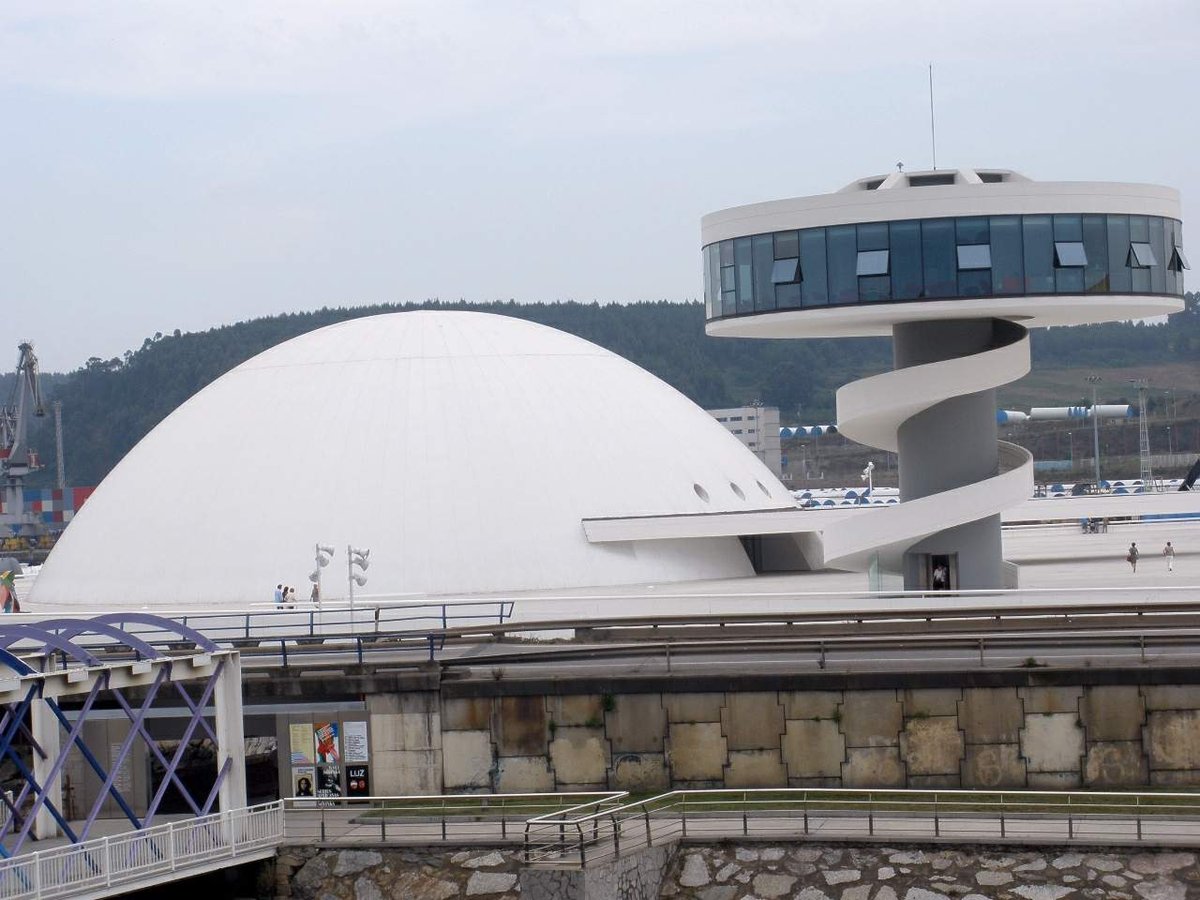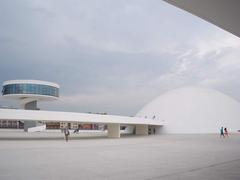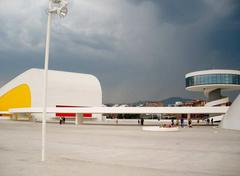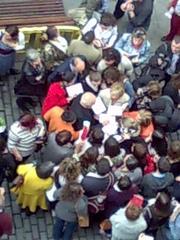
Centro Niemeyer: A Vision of Culture on the Avilés Waterfront
Date: 18/07/2024
Introduction
The Centro Niemeyer, inaugurated in 2011, stands as a beacon of cultural revitalization on the Avilés waterfront in northern Spain. Designed by the legendary Brazilian architect Oscar Niemeyer, this architectural marvel is emblematic of the transformation and renewal experienced by the city of Avilés. Once an industrial hub facing economic decline, Avilés has undergone a renaissance, with the Centro Niemeyer at the heart of this urban regeneration. This cultural center is not only a testament to Niemeyer’s visionary architectural style but also a symbol of community spirit and cultural exchange. It attracts visitors from around the globe, drawn by its unique design and diverse cultural offerings (ArchDaily) (Centro Niemeyer).
History and Architectural Significance
A Vision of Urban Renewal
The story of the Centro Niemeyer is deeply intertwined with the story of Avilés itself. Once a bustling industrial hub, Avilés faced economic decline and urban decay in the latter half of the 20th century. Seeking revitalization, the city embarked on an ambitious urban regeneration project, with the Centro Niemeyer at its heart. Oscar Niemeyer, celebrated for his signature style of modern Brazilian architecture, was commissioned for this monumental task.
Niemeyer’s Architectural Poetry
Known for his use of bold, curving forms and his belief that architecture should inspire and uplift, Niemeyer envisioned the Centro Niemeyer as a “place open to the world, a place of education, culture, and peace.” The result is a striking complex of five interconnected structures, each with its unique function, yet harmoniously integrated into a unified whole.
The complex, often described as a “square of civilizations,” features:
- The Dome: A signature Niemeyer design, the dome houses a multi-purpose exhibition space, its white concrete shell rising gracefully from a reflecting pool.
- The Auditorium: A vibrant red structure, the auditorium is a modern performance space designed for a variety of events, from concerts to theatrical productions.
- The Tower: A panoramic restaurant and viewing platform offering breathtaking views of the city and the Avilés estuary.
- The Building: This multi-functional space houses classrooms, workshops, meeting rooms, and a film library, serving as the center’s creative hub.
- The Open Square: A vast public plaza designed for open-air events and gatherings, connecting the center with the city and its people.
Architectural Significance
The Centro Niemeyer is a remarkable example of Niemeyer’s late-career work, showcasing his mastery of reinforced concrete and his ability to create monumental yet human-scaled spaces. The center’s design embodies several key elements of Niemeyer’s architectural philosophy:
- Organic Forms: The flowing curves and sinuous lines, inspired by the natural landscape of his native Brazil, are a hallmark of Niemeyer’s style. The dome, in particular, exemplifies this approach, its shape reminiscent of a wave or a sand dune.
- Social Function: Niemeyer believed that architecture should serve a social purpose, creating spaces that foster community and cultural exchange. The Centro Niemeyer, with its open plaza, multi-purpose spaces, and focus on education and the arts, reflects this belief.
- Use of Light: Niemeyer was a master of using natural light to enhance the spatial experience. The center’s design incorporates large windows, skylights, and strategic openings that bathe the interiors in natural light, creating a sense of openness and connection to the outdoors.
- Integration with Landscape: The Centro Niemeyer is not merely placed in the landscape but interacts with it. The reflecting pool surrounding the dome, the open plaza flowing into the surrounding park, and the views from the tower all emphasize this connection.
A Legacy of Innovation
The Centro Niemeyer stands as a testament to Oscar Niemeyer’s architectural genius and his enduring legacy. More than just a building, it represents a vision of urban renewal, a celebration of culture, and a beacon of hope for the future. The center continues to attract visitors from around the world, drawn by its architectural splendor, its diverse cultural offerings, and its inspiring story of transformation.
Visitor Information
Visiting Hours
The Centro Niemeyer is open to visitors daily, with the following hours:
- Monday to Friday: 10:00 AM - 8:00 PM
- Saturday: 10:00 AM - 9:00 PM
- Sunday: 10:00 AM - 7:00 PM
Ticket Prices
- General Admission: €10
- Reduced Admission (students, seniors): €5
- Free admission for children under 12
Accessibility
The Centro Niemeyer is fully accessible to visitors with disabilities, with ramps, elevators, and designated parking spaces available.
Travel Tips
- By Train: The nearest train station is Avilés, which is a short walk from the center.
- By Car: Ample parking is available on-site for those traveling by car.
- Local Accommodations: There are several hotels and guesthouses in the vicinity for visitors who wish to stay overnight.
Nearby Attractions
While in Avilés, visitors can explore other historical sites such as:
- Old Town (Casco Histórico): A charming area with cobbled streets, historic buildings, and quaint shops.
- Church of San Nicolás de Bari: A beautiful example of Gothic architecture.
- Palacio de Camposagrado: A stunning baroque palace.
Special Events and Guided Tours
The Centro Niemeyer hosts a variety of special events throughout the year, including art exhibitions, film screenings, and cultural festivals. Guided tours are available, offering in-depth insights into the architecture and history of the center.
Photographic Spots
For photography enthusiasts, the best spots within the Centro Niemeyer include:
- The reflecting pool around the dome
- The panoramic views from the tower
- The vibrant red auditorium against the blue sky
Social Impact and Community Engagement
Social Inclusion
Striving to make art and culture accessible to everyone, the Centro Niemeyer offers special programs for marginalized communities, including people with disabilities and those from disadvantaged socioeconomic backgrounds.
Intergenerational Dialogue
Programming often brings together people of different generations, fostering dialogue and understanding, especially through events combining traditional Asturian culture with contemporary art forms.
Community Partnerships
Collaborating with local organizations and community groups, the center develops programs and initiatives that address local needs and interests, ensuring relevance and responsiveness.
Challenges and Future Prospects
Financial Sustainability
Securing adequate funding is an ongoing challenge, relying on a combination of public subsidies, private sponsorship, and revenue from ticket sales and events.
Attracting and Retaining Talent
Avilés’s location can be a factor in attracting and retaining top talent. The center must offer competitive salaries and benefits to retain skilled professionals.
Expanding Reach
Efforts are ongoing to expand the center’s reach to a wider audience, both nationally and internationally.
Conclusion
The Centro Niemeyer is not just a cultural institution but a symbol of the transformation and revitalization of Avilés. Whether you are a local resident or a visitor, the center offers a rich blend of cultural, social, and educational experiences. Plan your visit today and explore the vibrant heart of Avilés (Centro Niemeyer) (Architectural Digest).
References
- Visiting Centro Niemeyer - History, Architecture, and Visitor Information, 2024, ArchDaily (source)
- Exploring Centro Niemeyer - Visiting Hours, Tickets, and Cultural Impact in Avilés, 2024, Centro Niemeyer Official Site (source)
- Visiting Centro Niemeyer - Hours, Tickets, and Cultural Highlights in Avilés, 2024, Architectural Digest (source)






